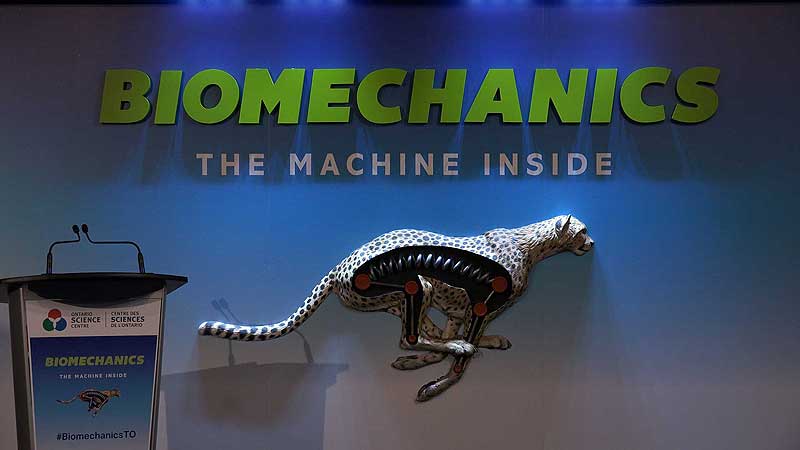Biomechanics: The Machine Inside reveals why all living things —including humans— are machines built to survive, move and discover. Comparing the similarities between muscles and motors, legs and springs, and claws and clamps, it explores the ways marvels of natural engineering have inspired ingenious man-made inventions.
This exhibition comprises seven sections:
Staying In One Piece: Structures and Materials
Learn how plants and animals manage to stay in one piece in a world where the crushing force of gravity, the pressure of water and the wind and the blows of other creatures all work to tear them apart. See how the dome-shaped construction of crabs, tortoises and even eggs provides amazing strength and protection.
Going with the Flow: Pumps and Pipes
Inside every living thing, fluids like blood circulate with a precise pressure, speed and volume to sustain life. See how –without metal, motors, or electricity – living things manage to drain, pressurise, push and recirculate these vital fluids. Five touchable models show how hearts of varying sizes and shapes serve as pumps to push fluid throughout the body.
Surviving the Elements: Insulation and Radiators
Life on Earth must endure the planet’s extreme temperatures. See what strategies and mechanisms plants and animals use to keep warm in icy seas or keep cool in broiling deserts. Using an interactive thermal camera, see how much heat you are losing at this very moment.
Grabbing a Bite: Jaws and Claws
Everything has to eat. But food can be scarce and competition fierce. Witness how animals use their inner machines – their muscles, levers and linkages–to grab on and take a bite. Amazing super slow motion video shows the hard-hitting spring mechanism of the psychedelic-looking Mantis Shrimp.
Crossing the Landscape: Legs and Springs
Launching into the Blue: Wings and Fins
Only a small fraction of the Earth is dry land. Over millions of years, living things have adapted to the dizzying heights of open skies and the crushing pressure of the deepest seas. View how creatures propel themselves through air and water and learn how flight evolved. «Fly» with an interactive that presents the pros and cons of long and short wings.
Gathering Intelligence: Eyes, Ears and Beyond
Eyes are among evolution’s most elegant gadgets. Look into how yours are an engineering marvel then go beyond the five familiar senses to explore seeing devices that need no light, brain tissue that detects the Earth’s magnetic field and antennae that smell. See how the asymmetric ear openings of a Northern Saw-whet Owl helps it master the challenge of nighttime hunting.
SOURCE: The Ontario Science Centre
-
Related materials:
- 29-Sep-2019 09:54 AM 👨🔬🔬 2019 OSC. 50th Birthday Community Weekend offers free general admission.
- 29-Sep-2019 09:39 AM 2019 OSC. 50th Birthday Community Weekend offers free general admission (4K, images)
- 26-Jun-2019 09:08 PM 2019 OSC. Weston Youth Innovation Award Ceremony (4K, images)
- 26-Jun-2019 08:18 PM 👨🔬🔬 2019 OSC. Weston Youth Innovation Award Ceremony
- 22-Aug-2018 06:06 AM 2018 OSC. Quantum: The Exhibition & New Eyes on the Universe (4K, images)
- 22-Aug-2018 01:10 AM 👨🔬🔬 2018 OSC. QUANTUM: The Exhibition and New Eyes on the Universe
- 24-May-2018 07:00 PM 👨🔬🔬 2018 OSC. POPnology EX Inauguration
- 24-May-2018 12:19 AM 2018 OSC. POPnology EX at the Ontario Science Centre (4K, images)
- 18-May-2018 05:00 AM 👨🔬🔬🐦 2018 OSC. FLAP Canada Annual Bird Layout
- 17-May-2018 05:43 PM 2018 OSC. FLAP Canada: “NO!” Birds Collisions Ex (4K, images)

